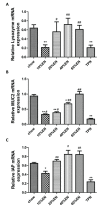Partial Enteral Nutrition Preserves Elements of Gut Barrier Function, Including Innate Immunity, Intestinal Alkaline Phosphatase (IAP) Level, and Intestinal Microbiota in Mice
- PMID: 26247961
- PMCID: PMC4555127
- DOI: 10.3390/nu7085288
Partial Enteral Nutrition Preserves Elements of Gut Barrier Function, Including Innate Immunity, Intestinal Alkaline Phosphatase (IAP) Level, and Intestinal Microbiota in Mice
Abstract
Lack of enteral nutrition (EN) during parenteral nutrition (PN) leads to higher incidence of infection because of gut barrier dysfunction. However, the effects of partial EN on intestina linnate immunity, intestinal alkaline phosphatase (IAP) and microbiota remain unclear. The mice were randomized into six groups to receive either standard chow or isocaloric and isonitrogenous nutritional support with variable partial EN to PN ratios. Five days later, the mice were sacrificed and tissue samples were collected. Bacterial translocation, the levels of lysozyme, mucin 2 (MUC2), and IAP were analyzed. The composition of intestinal microbiota was analyzed by 16S rRNA pyrosequencing. Compared with chow, total parenteral nutrition (TPN) resulted in a dysfunctional mucosal barrier, as evidenced by increased bacterial translocation (p < 0.05), loss of lysozyme, MUC2, and IAP, and changes in the gut microbiota (p < 0.001). Administration of 20% EN supplemented with PN significantly increased the concentrations of lysozyme, MUC2, IAP, and the mRNA levels of lysozyme and MUC2 (p < 0.001). The percentages of Bacteroidetes and Tenericutes were significantly lower in the 20% EN group than in the TPN group (p < 0.001). These changes were accompanied by maintained barrier function in bacterial culture (p < 0.05). Supplementation of PN with 20% EN preserves gut barrier function, by way of maintaining innate immunity, IAP and intestinal microbiota.
Keywords: gut barrier; innate immunity; intestinal alkaline phosphatase; intestinal microbiota; partial enteral nutrition.
Figures










Similar articles
-
Glutamine Improves Innate Immunity and Prevents Bacterial Enteroinvasion During Parenteral Nutrition.JPEN J Parenter Enteral Nutr. 2015 Aug;39(6):688-97. doi: 10.1177/0148607114535265. Epub 2014 May 16. JPEN J Parenter Enteral Nutr. 2015. PMID: 24836948 Free PMC article.
-
Glucagon-like peptide-2 improves intestinal immune function and diminishes bacterial translocation in a mouse model of parenteral nutrition.Nutr Res. 2018 Jan;49:56-66. doi: 10.1016/j.nutres.2017.10.007. Epub 2017 Oct 10. Nutr Res. 2018. PMID: 29420993
-
[Effects of enteral nutrition and parenteral nutrition on gut epithelial tight junction and barrier function in rats after surgical stress].Sichuan Da Xue Xue Bao Yi Xue Ban. 2009 Jul;40(4):615-8. Sichuan Da Xue Xue Bao Yi Xue Ban. 2009. PMID: 19764556 Chinese.
-
Intestinal alkaline phosphatase: novel functions and protective effects.Nutr Rev. 2014 Feb;72(2):82-94. doi: 10.1111/nure.12082. Epub 2013 Dec 9. Nutr Rev. 2014. PMID: 24506153 Review.
-
Changes to the Intestinal Microbiome With Parenteral Nutrition: Review of a Murine Model and Potential Clinical Implications.Nutr Clin Pract. 2015 Dec;30(6):798-806. doi: 10.1177/0884533615609904. Epub 2015 Sep 30. Nutr Clin Pract. 2015. PMID: 26424591 Review.
Cited by
-
Epidemiological and clinical features for cefepime heteroresistant Escherichia coli infections in Southwest China.Eur J Clin Microbiol Infect Dis. 2016 Apr;35(4):571-8. doi: 10.1007/s10096-015-2572-x. Epub 2016 Jan 27. Eur J Clin Microbiol Infect Dis. 2016. PMID: 26815433
-
How the Covid-19 epidemic is challenging our practice in clinical nutrition-feedback from the field.Eur J Clin Nutr. 2021 Mar;75(3):407-416. doi: 10.1038/s41430-020-00757-6. Epub 2020 Sep 16. Eur J Clin Nutr. 2021. PMID: 32939042 Free PMC article. Review.
-
Combinatory antibiotic treatment protects against experimental acute pancreatitis by suppressing gut bacterial translocation to pancreas and inhibiting NLRP3 inflammasome pathway.Innate Immun. 2020 Jan;26(1):48-61. doi: 10.1177/1753425919881502. Epub 2019 Oct 15. Innate Immun. 2020. PMID: 31615312 Free PMC article.
-
Gut microbiota-derived tryptophan metabolites improve total parenteral nutrition-associated infections by regulating Group 3 innate lymphoid cells.Imeta. 2025 Feb 26;4(2):e70007. doi: 10.1002/imt2.70007. eCollection 2025 Apr. Imeta. 2025. PMID: 40236767 Free PMC article.
-
Effects of n-3 PUFAs on Intestinal Mucosa Innate Immunity and Intestinal Microbiota in Mice after Hemorrhagic Shock Resuscitation.Nutrients. 2016 Sep 29;8(10):609. doi: 10.3390/nu8100609. Nutrients. 2016. PMID: 27690096 Free PMC article.
References
-
- Heneghan A.F., Pierre J.F., Tandee K., Shanmuganayagam D., Wang X., Reed J.D., Steele J.L., Kudsk K.A. Parenteral nutrition decreases paneth cell function and intestinal bactericidal activity while increasing susceptibility to bacterial enteroinvasion. JPEN J. Parenter. Enter. Nutr. 2014;38:817–824. doi: 10.1177/0148607113497514. - DOI - PMC - PubMed
MeSH terms
Substances
LinkOut - more resources
Full Text Sources
Other Literature Sources
Research Materials
Miscellaneous

